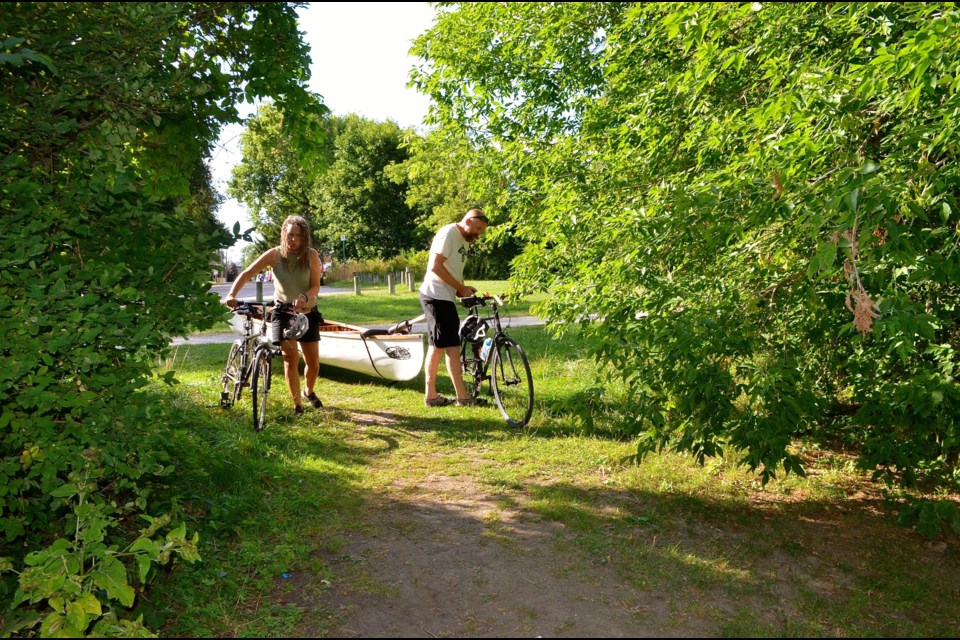At the end of July 2017 GuelphToday visited Jeremy Shute and his family as they prepared for the first leg of an epic canoe journey they call Speed to Sea.
“Our goal basically is to canoe from Guelph to the Atlantic,” said Shute. “I don’t know how we will define the Atlantic but it might just be some salt water or brackish water. We will see how far down the St. Lawrence we can actually get in these small boats. We will go as far as we can safely.”
This summer they embarked on the third leg of the journey and last weekend Shute and his wife Leslie Howarth loaded one of their canoes on a Wike bike trailer, pedaled to a quiet spot on the Speed River and put in to wet their feet and check for leaks.
“It’s a good idea to check for leaks now,” said Howarth with a grin as they pushed off.
The couple’s two sons Kofi and Nigel, Shute’s brother Jason and Howarth’s brother Frank are the other members of the Speed to Sea crew.
“It’s really just been us in the canoe going down but my parents have been kind of our support crew,” said Shute. “My mom and dad will be bringing my one son down a week into it and they are going to shuttle some vehicles for us and show up with the occasional cold drink.”
The first leg of the trip in 2017 took them from Guelph to Niagara Falls.
“We put in at the confluence here by the Boathouse and went down to the Grand River then down the Grand River to Lake Erie,” said Shute. “We went along the north shore at the east end of Lake Erie, down the Niagara River to Niagara Falls and stopped at the top of the Falls.”
Last summer they launched from Fort Erie.
“We crossed over the Niagara River to Buffalo, went down the Niagara River to Tonawanda and joined up with the Erie Canal,” said Shute. “We travelled down through a series of port towns – all these inland ports in New York State to just past Rochester to a little town called Pittsford.”
Pittsford was the starting point Thursday as they set off on the third leg.
“From Pittsford we will go across to Syracuse then up through the Oswego Canal to Lake Ontario,” said Shute. “We will be going through the Finger Lakes District then east on Lake Ontario towards Sackets Harbour.”
The next destination on the tour is Wolfe Island in Kingston.
“I don’t think we will make it that far,” he said. “I don’t think we will make it back into Canada, but we will make it to Lake Ontario.”
They will average about 30k of paddling per day over the next 15 days.
“As long as the wind isn’t against us, we are going about 5k an hour,” said Shute. “We are covering around 25k to 40k a day depending on whether we have to do car shuttles and things like that. That slows us down a bit.”
If all goes as planned they will reach the Atlantic in the early 2020s.
“I think we probably have three more legs,” said Shute. “Next year we will be out on the St Lawrence River and going down through the Thousand Islands toward Montreal.”
It’s a journey Shute has been planning since he was a kid.
“I don’t know if somebody has taken this route before,” he said. “I haven’t been able to find anybody that has done it. I have heard of people paddling through the Erie Canal and going down to New York City that way.”
The hardest part of the trip so far has been navigating the unpredictable waters of Lake Erie.
“Lake Erie has always been known as a dangerous lake for sailors,” he said. “It is a small shallow lake and the waves come up very quickly. I am a little apprehensive about the Lake Ontario stretch. It has the potential to be challenging.”
They plan to do some of their paddling at night when the waters tend to be calmer.
“It’s not always calm at night but it often gets calm in the evening and stays that way until the morning,” said Shute. “I am scouting out all the little harbours and little safe havens along the way – places where we can get off the water safely if we have to.”
He said canoes have their limitations but are still ideal for this kind of adventure.
“The canoe is indigenous technology that we are still using today because it was a perfectly designed vehicle for this landscape,” he said. “People make it out of different materials and that sort of thing but we are basically using something that was designed, I don’t know how long ago – 1,000 years ago?”
They are using ancient indigenous technology but the trip is in many ways an historical tour of urban and industrial development of the area since Europeans arrived.
“It’s not a wilderness trip,” he said. “You are learning about different things than you would if you were paddling on a northern river. We are seeing all these places with all this history and hearing stories from the people we meet along the way.”
He is recording those stories and posting their progress on the Speed to Sea Facebook page and Instagram account.
“A lot of people are interested in the trip and this is a way to follow us,” said Shute. “If anyone wants to come along just send me a message and they can come this year or next year.”

